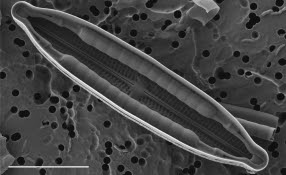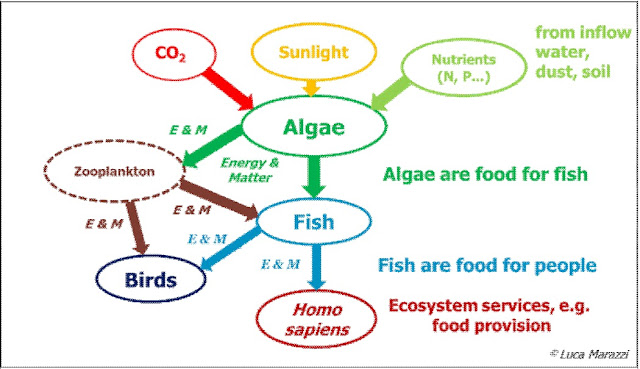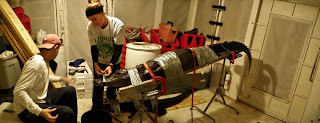Diatom of the month – March 2016: Mastogloia calcarea
by Luca Marazzi*
‘Who’
is it and where does it live?
This
diatom is a symmetric biraphid species, i.e. it has a raphe on either valve allowing
it to move sliding on substrata. Mastogloia calcarea was
‘discovered’ / described by Sylvia Lee during her PhD research at Evelyn Gaiser’s lab at FIU; it is similar
to M. smithii and M. lacustris,
common freshwater species in this predominantly marine genus. This new species
typically lives in karstic wetlands of the Caribbean region (Mexico, Jamaica
and Belize) and in the Florida Everglades, as compared to the temperate zones where M. smithii and M.
lacustris live
and are found1.

Mastogloia calcarea in valve (top) and girdle (bottom) view (http://westerndiatoms.colorado.edu/)1; scalebar = 10 µm.
Original
drawing of Mastogloia smithii labeled
341 and 341 β (source: Smith 1856)2.
Why
are we studying it?
Describing new species is obviously not just a
hobby performed by detail-loving biologists, but an essential way to discover
which organisms are where and why, given their size, shape, intra- and
extra-cellular features, motility or lack thereof, and so on. Taxonomic
investigations lead to the peer-reviewed establishment of new genera, species, varieties
via gradual time-consuming steps. Slate & Stevenson (2007)3
and Gaiser et al. (2010)4,
prepared the ground for the discovery of two new diatom species in the
Everglades by highlighting different morphology and ecology of two types of Mastogloia. In the end, Sylvia Lee described M. pseudosmithii alongside M. calcarea during her PhD with Evelyn
Gaiser. The former differs in morphology and ecology from this month’s diatom, that
instead prefers brackish (slightly salty) waters with higher phosphorus - coming
from seawater - and lower pH (due to higher peat accumulation)1;
whereas M. calcarea, a structural
engineer and keystone species (like cyanobacteria)3, is best adapted
to the lower phosphorus and higher pH conditions of the cohesive mats located
in the inland Everglades.
What
can you do?
As we
have learned, there are diatoms loving the freshwater they find in sawgrass-dominated
areas of the Everglades, and those preferring brackish waters towards the
ecological interface (ecotone) where the mangroves are creeping-in. With sea levels undoubtedly rising before our (either worried or indifferent) eyes,
saltwater is invading our (beloved or
too-swampy-and-mosquito-ridden-to-go-to) wetland’s freshwater areas from a
higher level, creating what FIU’s SERC
director Todd Crowl called ‘a pressure problem’ in a recent TED talk. So here is what
every (soon to be or already)
concerned citizen or visitor can do: explore the Everglades tomorrow or next
week or next month -alone, with your partner and/or kids! You can do it on
foot, by canoe or kayak, by airboat and overnight - you can even go on a full moon bike ride in Shark River Valley!
Abundant periphyton mats likely containing this diatom, where
the mangroves meet the sawgrass in lower Shark River Slough (Photo by Stephen
Davis – 26 June 2014).
This
will help you understand why we study plants, animals, and even tiny
glassed-celled algae called diatoms: they are our witnesses of the fast rise of
sea level that is transforming marshes into brackish water ponds, and will
flood large parts of Miami and South Florida sooner than we thought. And there
is no time to waste to find the solutions to cut
the heat-trapping gas emissions that warm the planet, and thus thermally
expand the oceans’ volume and further increase sea level by glaciers’ and
icesheets’ melting. Everyone can do their small part, for example following simple
steps to cut our carbon footprint; these
choices / actions can, like a drop in the ocean, slow down climatic changes and
create a new more sustainable world, for real!
1. Lee S.S., Gaiser E.E.,
Van de vijver B., Edlund M.B. & Spaulding S.A. 2014. Morphology
and typification of Mastogloia smithii and M. lacustris, with descriptions of
two new species from the Florida Everglades and the Caribbean region. Diatom
Research 29: 325– 350.
Smith W. 1856. Synopsis of the British Diatomaceae. Volume 2. J. Van
Voorst, London. 107 pp.
3. Slate J.E. & Stevenson R.J. 2007. The
diatom flora of phosphorus-enriched and unenriched sites in an Everglades
4. Gaiser E.E., La Hée J.M., Tobias F.A.C.
& Wachnicka A.H. 2010. Mastogloia
smithii var. lacustris Grun.: A
structural engineer of calcareous mats in
karstic subtropical wetlands. Proceedings
of the Academy of Natural
Sciences of
Philadelphia 160:
99–112.





Comments
Post a Comment